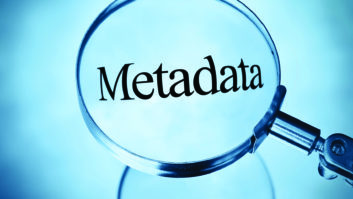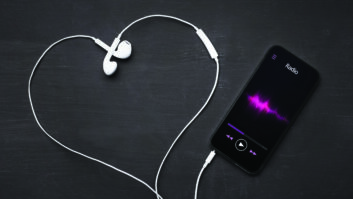IBiquity Digital and the National Association of Broadcasters believe there’s a low-cost way for analog AM stations to transmit simple text data, much as FM stations can with the Radio Data System.
The service would be compatible with AM HD Radio as well, and its proponents say it would provide broadcasters with an intermediate step toward a full digital IBOC implementation.
A system akin to “RDS for AM” has long been bandied about by engineers, but little came of it. Now the two organizations are exploring interest among stations and receiver makers in the technology to enable analog AMs to transmit data to display as messages on analog and HD Radio receivers.
The concept is similar to what analog FMs can provide using RDS subcarriers; but this system uses a small number of IBOC digital subcarriers to provide data capability. If the project proceeds to the next phase, the subcarrier power levels suggested in a new report would be verified in laboratory and field testing.

The proposed system uses digital subcarriers at 181.7 Hz (±1) offset from the analog carrier, 363.4 Hz (±2) offset from the analog carrier, and (optionally) 545.1 Hz (±3) offset from the analog carrier, according to the report. Each subcarrier power level is set to ensure robust reception and minimize interference to the host analog audio.
IBiquity has been working on the concept; NAB’s FASTROAD technology development project co-funded the project and recently released iBiquity’s report on how it could work and what would be involved for stations and manufacturers. FASTROAD stands for Flexible Advanced Services for Television & Radio on All Devices.
“The AM Digital Data Service is structured to be compatible with HD Radio IBOC broadcasting on AM and defined to be implemented in a cost-effective manner,” according to the report.
The technology supports delivery of low-data-rate text — approximately 90 to 1,000 bits per second depending on the number of subcarriers and the type of modulation used — for analog AMs. By comparison, the RDS signal has a bit rate of approximately 1,200 bits per second.
Right now, AMs have no way of transmitting text data such as song title, artist name or sponsor information. This technology could be integrated into future HD Radio and analog receivers, according to the report.
The proposed system uses several building blocks from the AM IBOC standard, though it’s not meant to be a full digital system. The ADDS is meant to transmit text data only and not digital audio.
This report, available at www.nabfastroad.org, summarizes system design alternatives, possible transport definitions and impact on industry products. Several system components are borrowed from the HD Radio standard in an effort to simplify implementation. “Such a service would provide analog AM broadcasters with a step toward a full digital broadcast,” it stated.
The document does not define a full ADDS standard or a commercial implementation. Additional system design work is required to implement and evaluate a commercial AM Digital Data Service, the authors wrote.
The transmission equipment needed at a station hasn’t been determined; however, NAB and iBiquity expect that ADDS offers stations a simpler, less expensive way to provide a limited digital data service compared to a full-blown AM IBOC installation, according to NAB Science & Technology Senior Director of Advanced Engineering David Layer.
“Also, the requirements on the antenna system for ADDS would be the same as for analog AM and not the more stringent requirements of AM IBOC,” said Layer. “This is important because antenna tuning, getting systems from analog AM to HD Radio specs, has been one of the major tasks needed to get AM IBOC functioning.”
The report describes methods for digital signaling within an AM analog broadcast signal and options/tradeoffs for application layer implementation. Although other AM digital signaling methods have been proposed worldwide, the method described is intended to be at least partially compatible with an HD Radio signal, using a subset of the modulation techniques designed for AM HD Radio transmission equipment and receivers.
As described in the report, from one to three digital subcarrier pairs would be used to transmit digital data. These subcarriers would reside “underneath” the existing analog AM audio signal, represented in the first illustration by the trapezoidal shape that extends symmetrically about the channel center out to approximately ±10 kHz.
(click thumbnail)
The report showed this generalized AM broadcast configuration, defining the basic functional blocks required. The GPS timing reference and AM exciter would have to support synchronization and modulation of the AM Digital Data Service. Complete specifications and designs of these components would require further study, they wrote. “The proposed system uses digital subcarriers at 181.7 Hz (±1) offset from the analog carrier, 363.4 Hz (±2) offset from the analog carrier, and (optionally) 545.1 Hz (±3) offset from the analog carrier. Each subcarrier power level is set to ensure robust reception and minimize interference to the host analog audio,” the text states.
ADDS is designed to support text messaging and data transmission associated with audio program content. Proposed “use cases” include station service messages, alert messages and program service messages such as song title and artist, genre and commercials. The ADDS may also provide emergency alert text messages or interactive ads.
In the second figure, the report discusses what studio equipment stations would need to use the technique. The architecture described in the report defines the basic functional blocks required.
The GPS timing reference and AM exciter would have to support synchronization and modulation of the ADDS. Stations would need a simplified version of an HD Radio AM exciter with a data interface to support the text message input.
Stations, according to the findings, should have studio automation equipment that supports HDP PSD SDK V4.7 or later. HDP PSD SDK V4.7 refers to the HD Radio software application protocol for program service data transport into the broadcast equipment.
“The studio should have a data services line to the transmitter to convey the content. A phone link with 9600 baud modem to the transmitter site would be sufficient to support the data required at 300 bps. If available, STL service would provide more robust capacity.”
The ADDS technology could be integrated into future IBOC and analog receivers. Line text displays should be appropriate for most use cases; however, receiver specs would need to be developed to guide product designers and manufacturers. Existing IBOC receivers and analog-only receivers would not be able to decode the ADDS signal.













